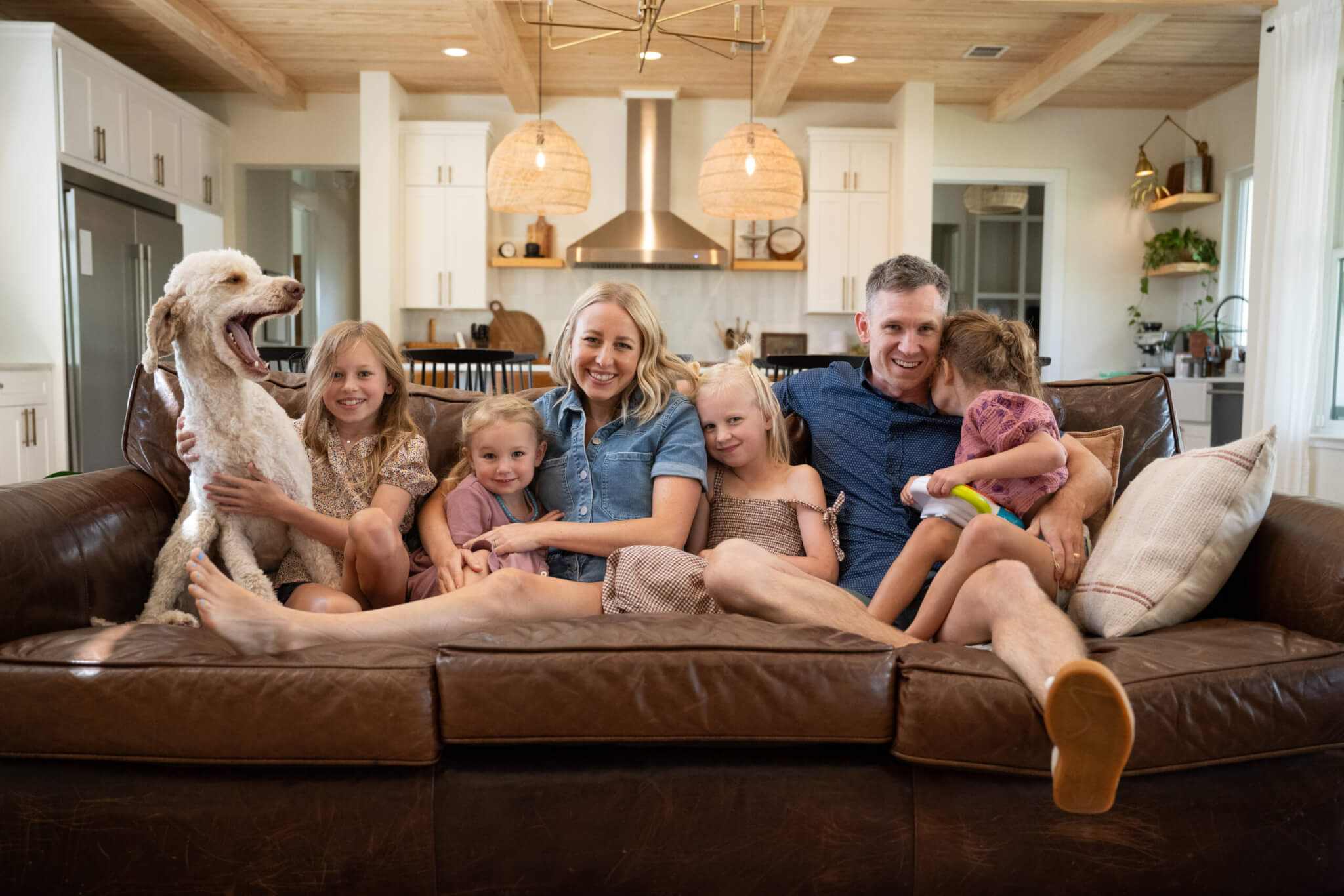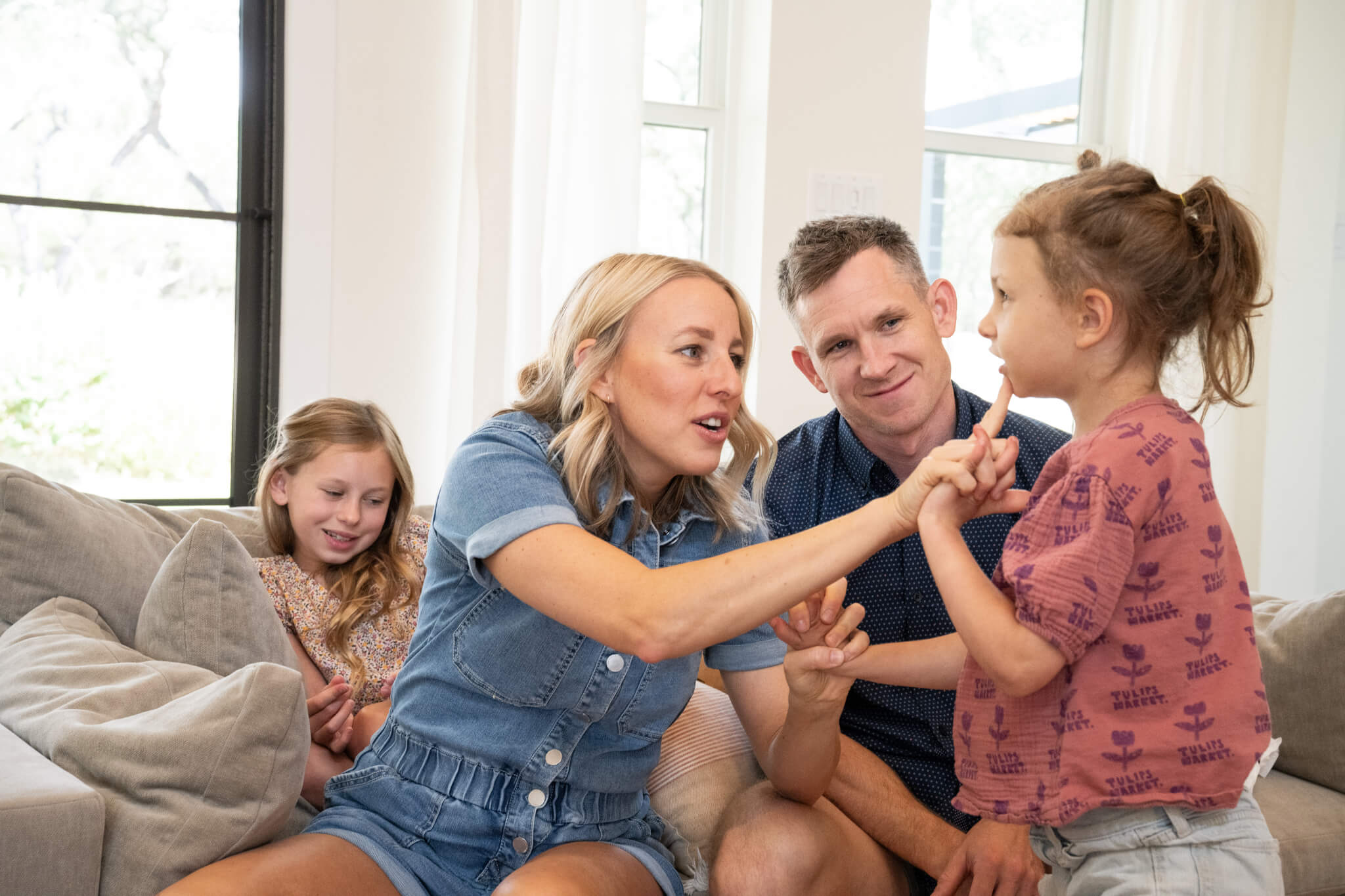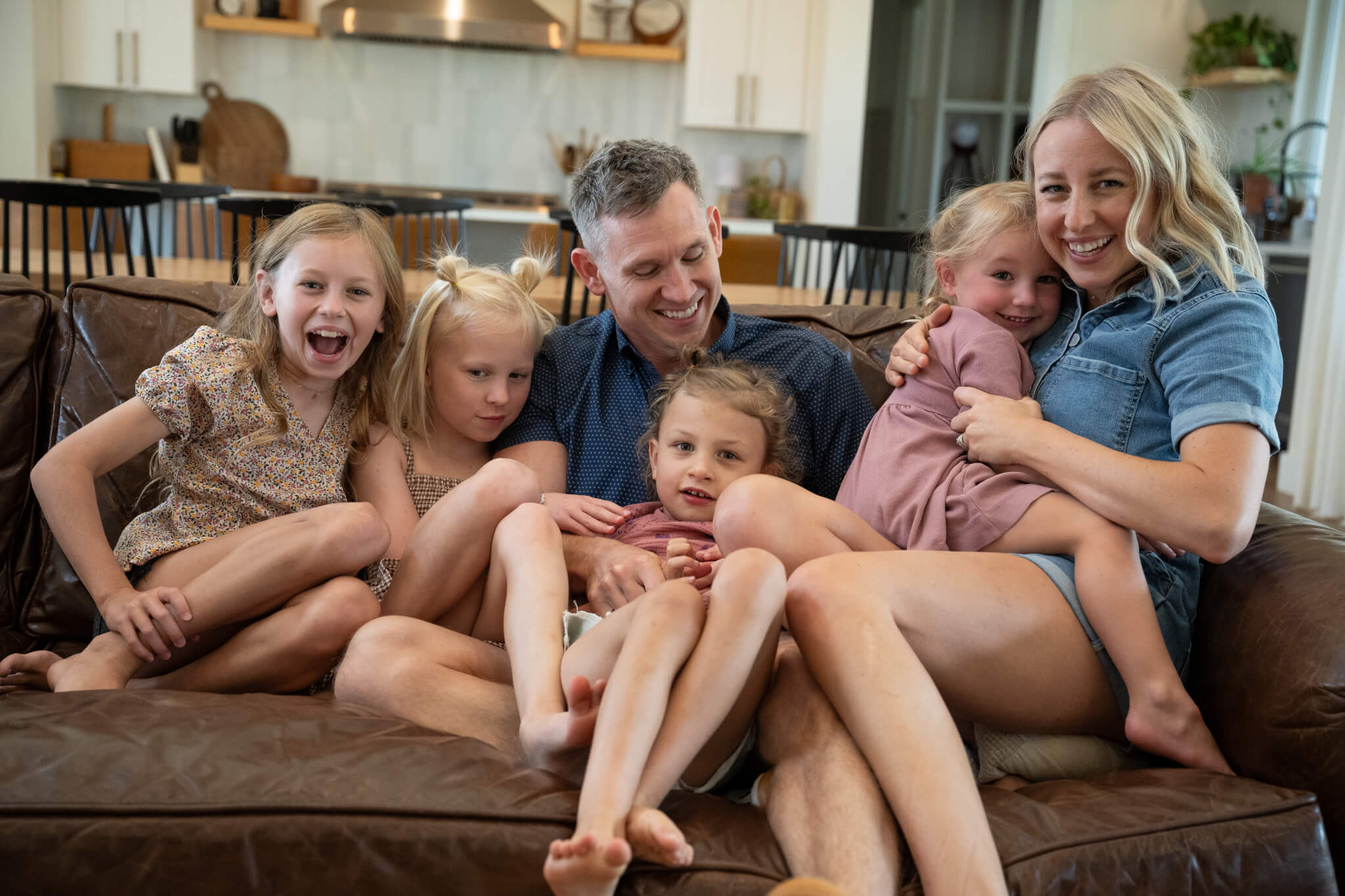
Words by Bekah McNeel
Photos by Wendi Poole

No one else was all that alarmed in 2018 when Lyndsey Moore started to notice something about her third daughter, Remmie. Remmie looked just like her two older sisters—fair hair, light eyes, spritely. But with the baby and toddler milestones fresh in her mind from the older girls, Lyndsey knew that Remmie was not physically developing as she should.
“She felt stuck as a baby,” she said. “It was sort of an intuition. We were waiting, waiting and those milestones were not coming.”
When Grant and Lyndsey Moore were on summer staff at LLYC 12 years earlier, they could not have imagined the challenges they would face raising Remmie. In 2006, they were in their last years of college and had been dating since high school. In the middle of a skit one night at Roundup, Grant contrived a way to get them both on stage, and he popped the question in front of a crowd of cheering campers.
 The next 12 years unfolded according to plan. One blonde baby girl after another filled their impeccably decorated home with giggles. Crawling became running. Babbles became conversations. When that wasn’t happening for Remmie, the Moores could see their fairytale taking an unexpected turn.
The next 12 years unfolded according to plan. One blonde baby girl after another filled their impeccably decorated home with giggles. Crawling became running. Babbles became conversations. When that wasn’t happening for Remmie, the Moores could see their fairytale taking an unexpected turn.
What felt like a detour would soon become a bigger story— one that would change their understanding of God … and the American healthcare system.
Each doctor’s appointment ruled out one terrifying possibility after another, only to leave them with options that were scarier, and far rarer. Finally, in 2019, they got an answer. Remmie, now 16 months, has ALG13-CDG, a genetic disorder that affects fewer than 1,000 Americans. It affects how her body processes sugar, preventing some glucose-dependent systems from developing like they would in other children.
The prognosis wasn’t good. Because the condition is so rare, there hasn’t been much progress toward effective therapies to encourage physical and cognitive development or to prevent the frequent seizures.
As Remmie grew, the seizures did too, and so did the medical bills. Even managing Remmie’s day-to-day care was stretching the Moores’ budget. For a while, both Grant and Lyndsey were working. Their combined salaries allowed them to buy a house in a nice neighborhood. Lyndsey took a teaching job at the same private Christian school where they had met and fallen in love. They could stretch a dollar to cover the extra years of diapers, wipes, and necessary supplements.
But adapting their home to their daughter’s needs came with bills in the tens of thousands. One example: her nighttime seizures became so severe that she regularly pitched dangerously out of her bed. There’s a solution for this: a Cubby Bed system specially designed for kids like Remmie who need multiple extra layers of safety. Insurance would not cover the bed, and the out-of-pocket cost was $33,000. The bed remains on the running list the Moores must keep, something between a wish list and a roadmap.
When Lyndsey’s parents gifted them land, they built a house with Remmie’s known and unknown long-term needs in mind. The floorplan would prioritize wheelchair access and medical equipment storage, while limiting ways Remmie might injure herself. They used their budget to prioritize functionality, relying on Grant’s love of DIY projects to make it feel more like home.
But as they soon learned from other parents whose children had disabilities similar to Remmie, their home needed to become a specialized therapy center, with new and costly equipment for each new stage of Remmie’s life. “When she’s 14, her therapy will look different,” Lyndsey said, surveying the bedroom and its current makeshift state. From walking to talking to feeding herself, every milestone for Remmie is hard won, and their house is where the work is done.

The Moores have private insurance through Grant’s job at a regional retail chain, but most of Remmie’s needs are not covered. They make too much money to qualify for Medicaid. Most grants and foundation assistance go to people below the poverty line. Many also are designated for certain neighborhoods, cities, or geographic regions. Any Baby Can and the Multi-Assistance Center at Morgan’s Wonderland were able to help with some items, like diapers and a wagon, but that big ticket stuff? The things that will actually help Remmie develop? Those costs fall entirely on the family.
Like so many parents of medically fragile children, Lyndsey’s life became a rollercoaster of hope, disappointment, and growing expertise in a system she never really thought she’d have to navigate. A foundation would sound hopeful when she called to inquire about applying for a grant, only to find out months into the process that for whatever reason, they did not meet the criteria. “There were just so many parameters on everything,” Lyndsey said.
When the cost of medical care exceeds what insurance will cover, or when necessary treatments and equipment are not covered by insurance, it creates a “coverage gap.” With a current household income in the mid-$100,000s and employer-provided insurance, the Moores demonstrate just how wide these gaps can be. Even with the support and safety nets they have through family, the Moores are having to choose which of their daughter’s needs they can afford to meet. If their income were lower—as it is for most Texas families—even more of those needs would go unmet.

Researchers at Columbia University’s Mailman School of Public Health found that one in five insured children—either through public or private insurance—are inadequately insured, and out-of-pocket expenses are more than their families can afford. In other words, they have insurance, and it doesn’t cover their medical needs. Multiple studies followed families who have children with special needs and found that the high cost of medical care inside these gaps places many families in hardship, even if they were financially stable before.
As Remmie grew and it became clear that her needs were increasing, Lyndsey quit her job, becoming part of what researchers have labeled the “shadow workforce” in home-based medical care. A 2016 survey found that in families with children who have complex medical needs, 60 percent had a parent quit their job to become a full-time caregiver. For Lyndsey, this felt essential, as a mother. Of course she would care for Remmie. But losing her income only made the gap wider, and her anxiety was mounting.
Concern for their other daughters keeps Grant and Lyndsey awake at night, too.
Remmie’s condition puts stark limits on what the Moores can do as a family, from extracurricular schedules to their decision to homeschool their children. Their large extended families are both nearby, but the Moores can’t make it to events that will break up Remmie’s routine too much, and finding a babysitter who can handle the physical and psychological intensity of caring for Remmie (including seizure protocols) isn’t easy. Grant and Lyndsey haven’t been away overnight once since she was born. Even date nights are few and far between.
Insurance would not cover the bed, and the out-of-pocket cost was $33,000. The bed remains on the running list the Moores must keep, something between a wish list and a roadmap.
“It’s a gradual letting go of what you thought life was going to look like,” Grant said.
At the same time, the Moores believe that Remmie is who she is for a reason, and Lyndsey trusts God to care for her family. “As parents, you have to give your kids to the Lord every day,” she said. “And I can see what he is doing in our other kids.”
She’s also seeing God in Remmie’s story. As Lyndsey prayed about her family, she received what she and Grant consider to be a word from God.
“He told me, ‘It’s time to stop doing this alone,’” Lyndsey recalled. She felt a deep conviction that God was “raising up an army” to support them, and that Remmie’s story would ultimately demonstrate God’s goodness.
The more Lyndsey shared their story over social media, the more people reached out with their own struggles, including those who were at their wits end with healthcare, special education services, and the myriad systems parents have to fight when they have a child with special needs. “Everyone this side of heaven is walking through some kind of suffering,” Lyndsey said.
They also received more support than they had anticipated. Donations to Remmie’s medical funds, connections to a free wheelchair, even someone who had worked with Lyndsey’s sister at LLYC reached out to donate a therapy dog, a mini goldendoodle who happens to look a lot like George, the family’s full size goldendoodle.
The stories made the Moores feel less alone, and also made them grateful for the family and financial resources they do have. Not everyone they meet has an army they can muster or a faith that encourages them on the darkest days.
At the end of March 2024, the Moores learned about the work Brandon Crawford was doing at NeuroSolution and NeuroRestoration Center of Austin. Crawford’s work seemed like exactly the treatment they’d been hoping for.
Saying yes to the treatments was both thrilling and terrifying, but the immediate decrease in Remmie’s seizures confirmed that it was essential. Insurance isn’t covering the therapy, and the costs quickly neared six figures in the first year.
Local nonprofits in their community, their church family, LLYC friends, and that army of online supporters have pitched in to what Lyndsey called the “Root for Remmie” campaign. She sold t-shirts and hosted a BBQ and raffle in October. All in all, the event tickets and t-shirts raised over $20,000, and in September when we talked, Lyndsey was hoping to see the raffle raise another $40,000.
The Moores aren’t ruling out prayers for a dramatic change to the insurance and healthcare system challenges that make all of this necessary. The treatment at NeuroSolution has gotten preliminary approval in Australia, which could lead to FDA approval in the United States and insurance coverage. But the treatment is not the end of Remmie’s journey. The considerable progress she’s made will have to be supported by new therapies and new treatments.
Even if God’s next miracle isn’t a dramatic change to the US healthcare system, Remmie’s parents are committed to the challenge.
Local nonprofits in their community, their church family, LLYC friends, and that army of online supporters have pitched in to what Lyndsey called the “Root for Remmie” campaign.

Hope and generosity always start somewhere. For Mrs. Butt, it was often the place where her family gathered to share meals.